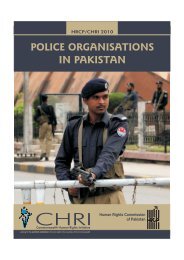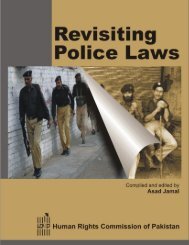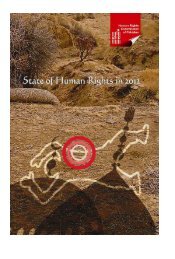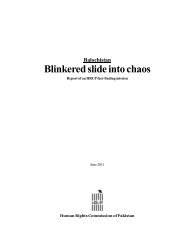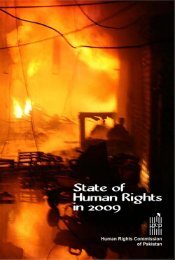Judical Action to end Bonded Labour - Human Rights Commission ...
Judical Action to end Bonded Labour - Human Rights Commission ...
Judical Action to end Bonded Labour - Human Rights Commission ...
You also want an ePaper? Increase the reach of your titles
YUMPU automatically turns print PDFs into web optimized ePapers that Google loves.
While the fact that as a federal law the Act of 1992 prevailed over any provincial law<br />
was evident, the court examined the argument that the Sindh Tenancy Act of 1950 was not<br />
applicable <strong>to</strong> the two appellants, and expressed the view that ìin the absence of a finding as<br />
<strong>to</strong> the existence of a tenancy under the Sindh Tenancy Act the <strong>Bonded</strong> <strong>Labour</strong> System<br />
(Abolition) Act, 1992 would be fully applicable <strong>to</strong> the caseî.<br />
As for the question of conflict between the two laws under reference, the court made<br />
a detailed examination of the Sindh Tenancy Act, 1950, and came <strong>to</strong> the conclusion that<br />
ìthere could be no justification for forcing him (a tenant) <strong>to</strong> work against his will in flagrant<br />
violation of his fundamental rightsî. The plea that the High Court was wrong in assuming that<br />
every detenue was a permanent tenant of the respective landlord was accepted.<br />
Taking up the appellantsí argument that the High Court was required <strong>to</strong> examine<br />
each petition under Article 199 of the constitution and Section 491 of CrPC on merits, the<br />
court stressed the fact ìthat the writ of habeas corpus, which is of ancient origin, as<br />
distinguished from other prerogative writs, is one of right and not mere discretionî. The<br />
petitions could not be dismissed (by the High Court) on the ground that alternative remedies<br />
were available. The court rejected the attempt <strong>to</strong> make a distinction between private cus<strong>to</strong>dy<br />
and public cus<strong>to</strong>dy and quoted the Supreme Courtís observation in Abrar Hasan vs<br />
Federation ìthat even if a judge of the Supreme Court were <strong>to</strong> illegally confine his domestic<br />
servant for misbehaviour, a writ of habeas corpus would lie against himî.<br />
Finally, the court elaborated upon the powers of the judiciary under the Pakistan<br />
constitution and held that ìany form of restraint on liberty is actionable both under Article 199<br />
of the constitution and Section 491 CrPCî.<br />
This landmark verdict quashed quite a few arguments that were adopted by landlords<br />
<strong>to</strong> evade their responsibilities under the <strong>Bonded</strong> <strong>Labour</strong> System (Abolition) Act, 1992, and<br />
perpetuate the exploitation of their workers as bonded labour.<br />
These judicial verdicts also <strong>end</strong>ed the controversy that the bonded labour in<br />
agriculture had <strong>to</strong> be treated differently than those working at brick-kilns.<br />
In the first case (Darshan Masih vs State) the Supreme Court dealt with brick-kiln<br />
workers as they were the only petitioners. The reports by various fri<strong>end</strong>s of the court offered<br />
a fairly complete picture of the bonded labourís exploitation at brick-kilns. The authors of<br />
these reports did not fail <strong>to</strong> call for legislation and policies aimed at eliminating bonded labour<br />
in all spheres of life.<br />
The second Supreme Court decision was given in a case born out of agriculture<br />
workersí exploitation as bonded labour in Sindh. Neither in this judgment nor in the impugned<br />
Sindh High Court judgment the condition of bonded haris was discussed.<br />
The plight of these bonded haris began <strong>to</strong> attract public attention in the 1990s when<br />
HRCPís Special Task Force at Hyderabad discovered large bodies of bonded labourers at<br />
agricultural farms. Here <strong>to</strong>o whole families were engaged in labour, wages were extremely<br />
low, a vicious system of peshgi was in force, and women/children were often subjected <strong>to</strong><br />
sexual abuse. As in the case of brick-kiln labour the pesghi amount kept rising and the haris<br />
could never hope <strong>to</strong> pay it back. The bonded haris were not allowed <strong>to</strong> move away from their<br />
thatched jhuggies and force was used <strong>to</strong> restrain their movements. Many cases of labourers<br />
being kept in chains or confined <strong>to</strong> prison-like quarters came <strong>to</strong> light. Also widely reported<br />
were instances of bonded labour being bought by landlords, who needed extra labour, by<br />
paying the previous ëownerí the peshgi amount due from them. The labourers who escaped<br />
from the places of detention were captured, often with the help of the police or private<br />
militias, and <strong>to</strong>rtured.<br />
When HRCP activists started securing the bonded harisí release through reports <strong>to</strong><br />
the police and habeas corpus petitions, the landlords <strong>to</strong>ok the plea that the bonded haris<br />
--- xi ---



